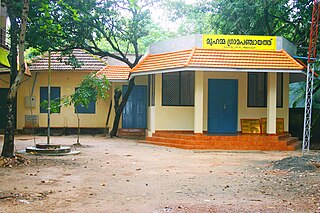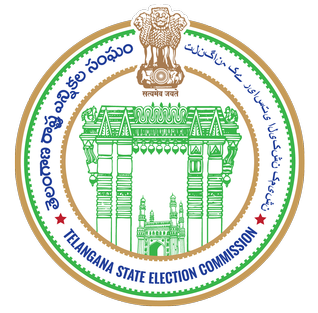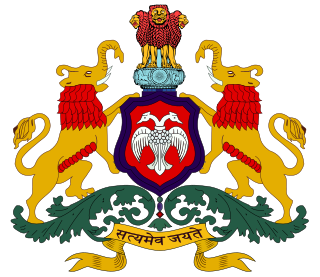Related Research Articles
Gram Panchayat is a basic governing institution in Indian villages. It is a political institution, acting as the cabinet of a village or group of villages. The Gram Sabha works as the general body of the Gram Panchayat. The members of the gram panchayat are elected directly by the people. The gram panchayat is headed by an elected President and Vice President, assisted by a Secretary who serves as the administrative head of the panchayat. The president of a gram panchayat is known as a "Pradhan" or "Sarpanch" in Northern India. There are about 250,000 gram panchayats present in India.
A sarpanch, gram pradhan, mukhiya, or president is a decision-maker, elected by the village-level constitutional body of local self-government called the gram sabha in India. The sarpanch, together with other elected panchayat members, constitute gram panchayats and zilla panchayats. The sarpanch is the focal point of contact between government officers and the village community and retains power for five years. the term used to refer to the sarpanch can vary across different states of India. Here are some of the commonly used terms for sarpanch in various states: panchayat president, gram pramukh, gram pradhan, gram adhyaksha, gaon panchayat president, gram panchayat president, etc.
Panchayat samiti or block panchayat is a rural local government (panchayat) body at the intermediate tehsil (taluka/mandal) or block level in India. It works for the villages of the tehsil that together are called a development block. It has been said to be the "panchayat of panchayats".

Panchayati raj is the system of local self-government of villages in rural India as opposed to urban and suburban municipalities.
Local government. in Maharashtra State follows the general structure of Local Governance in India and is broadly classified into two categories: Urban Local Governance and Rural Local Governance.
The Ministry of Panchayati Raj is a branch of the Government of India. Ministry of Panchayati Raj looks into all matters relating to the Panchayati Raj and Panchayati Raj Institutions. It was created in May 2004. The ministry is headed by a minister of cabinet rank / Minister of State and transfers grants to rural local bodies for civic programs such as maintenance and construction of roads, pavements, bridges, drainage systems, parks, piped water supply, streetlights etc.
Kerala is a state on the southwestern coast of India. It is known for its high literacy rate, low infant mortality rate, and long life expectancy.
Municipal or local governance refers to the third tier of governance in India, at the level of the municipality or urban local body.
A district planning committee (DPC) is the committee created as per article 243ZD of the Constitution of India at the district level for planning at the district and below. The committee in each district should consolidate the plans prepared by the Panchayats and the municipalities in the district and prepare a draft development plan for the district.
Local government in India is governmental jurisdiction below the level of the state. Local self-government means that residents in towns, villages and rural settlements are the people who elect local councils and their heads authorising them to solve the important issues. India is a federal republic with three spheres of government: union, state and local. The 73rd and 74th constitutional amendments give recognition and protection to local governments and in addition each state has its own local government legislation. Since 1992, local government in India takes place in two very distinct forms. Urban localities, covered in the 74th amendment to the Constitution, have Municipality but derive their powers from the individual state governments, while the powers of rural localities have been formalized under the panchayati raj system, under the 73rd amendment to the Constitution.
Local bodies in Tamil Nadu constitute the three tier administration set-up in the South Indian state of Tamil Nadu. It is a system of local government which forms the last level from the Centre. Chennai Corporation in the then Madras Presidency, established in 1688, is the oldest such local body not only in India but also in any commonwealth nations outside United Kingdom.

The Telangana State Election Commission officially, State Election Commission of Telangana, is an autonomous, independent Constitutional and Statutory authority of Telangana. It was formed under the Constitution of India as per the provisions of the 73rd and 74th Amendments Acts of 1992. All Local Body elections of Telangana are conducted by this agency.

The Panchayat raj is a political system, originating from the Indian subcontinent, found mainly in India, Pakistan, Bangladesh, Sri Lanka, and Nepal. It is one of the oldest systems of local government in the Indian subcontinent, and historical mentions date to around 250 CE. The word raj means 'rule' and panchayat means 'assembly' (ayat) of 'five' (panch). Traditionally, panchayats consisted of wise and respected elders chosen and accepted by the local community. These assemblies settled disputes between both individuals and villages. However, there were varying forms of such assemblies.
The Uttarakhand State Election Commission is an autonomous, independent, constitutional and statutory authority of the Indian state of Uttarakhand. It was formed on 30 July 2001 under the Constitution of India through the provisions of the 73rd and 74th Amendments Act of 1992.
Elections to the local bodies in Uttarakhand, India, are conducted once in five years to elect the representatives to the urban and rural local bodies. These elections are conducted by the Uttarakhand State Election Commission and were mandated by the 74th Constitutional Amendment Act to ensure local government in urban and rural areas.
The 74th constitutional amendment act mandated the setting up and devolution of powers to Urban local bodies (ULBs) or city governments as the lowest unit of governance in cities and towns. This landmark initiative of the Government of India in 1993 was built upon the premise that all ‘power’ in a democracy rightfully belongs to ‘the people’. Power was mandated to be given to the people via the local bodies, namely Municipal Corporations, Councils and Nagar Panchayats, which would have representatives that are elected regularly and have a decisive role in planning, provision and delivery of services.

The Kuttippuram Block Panchayat is the block-level administrative body that administers the region around Kuttippuram in Malappuram district, Kerala, India. It is also one of the 15 Block Panchayats established for the proper block-level administration of Gram panchayats in the district. Established in 1962, the block's current president is Vaseema Veleri since 2020. Kuttippuram Block Panchayat lies in two assembly constituencies – Kottakkal and Tirur – both of which are part of the Ponnani parliamentary constituency. The Block is headed by a President and council, and manages 155.83 km2 of Kuttippuram block, with a population of about 229,468 within that area.
Local government in Karnataka is the third tier constituting the three-tier administration set-up in the Indian state of Karnataka. It is a system of local government which forms the last level from the Centre.

Karnataka State Election Commission is an autonomous and statutory body constituted in Indian state of Karnataka for ensuring that elections in are conducted in free, fair and unbiased way. Constitution of India with provisions as per Article 243K and 243 ZA and Article 324 ensures creation and safeguarding of the powers of State Election Commissions. Karnataka State Election Commission came into existence with the promulgation of 73rd and 74th amendment to the Constitution of India on 26 May 1993 with an objective of superintendence, direction and control of the preparation of electoral rolls and to conduct all elections to the Urban Local Bodies and Rural local bodies like Municipalities, Municipal Corporations, Panchayats and any other specified by Election Commission of India. Karnataka State Election Commissioner is appointed by Governor of Karnataka.